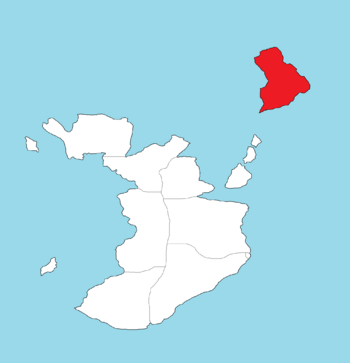Saint Emile
The Province of Saint Emile | |
|---|---|
|
Flag | |
 Province of Saint Emile | |
| Capital | Picard |
| Official languages | English, French |
| Demonym(s) | Emilier |
| Government | |
• First Minister | Edgar Russel |
| Legislature | Legislative Assembly |
| Establishment | |
• Colonized by Cartier | December 19, 1518 |
• Organized as Parish of Louste Island | June 12, 1519 |
• Parishes elevated to Provinces | July 20, 1750 |
| Area | |
• Total | 21,831 sq mi (56,540 km2) |
| Population | |
• 2020 estimate | 1,384,930 |
• Density | 63.44/sq mi (24.5/km2) |
| GDP (PPP) | estimate |
• Per capita | $43,000 |
| GDP (nominal) | estimate |
• Total | $59,551,990,000 |
Saint Emile; sometimes abbreviated as SE) is the northernmost province of Cheirol, in the country's Island region. It is composed of the island of Saint Emile and surrounding uninhabited islands. In 2020, the province's population was estimated at 1,384,930.
The province is Cheirol's most linguistically homogeneous, with 97.0% of residents reporting English as their mother tongue in the 2016 census. Historically, Saint Emile was also home to unique varieties of Cartiquos French.
Saint Emile's capital and largest city, Picard, is Cheirol's nth-largest census metropolitan area and is home to almost n% of the province's population. Picard is the seat of government, home to the Legislative Assembly of Saint Emile and to the highest court in the jurisdiction, the Supreme Court of Saint Emile.
Economy
Due to a major energy and resources boom, the provincial economy has had a major turnaround since the turn of the 21st century. Unemployment rates decreased, the population stabilized and had moderate growth. The province has gained record surpluses, which has rid it of its status as a "have not" province.
Service industries accounted for the largest share of GDP, especially financial services, health care and public administration. Other significant industries are mining, oil production and manufacturing.
Mines in Saint Emile produced a total of $3.3 billion worth of ore in 2010. The province produces 55% of Cheirol's total iron ore. Quarries producing dimension stone such as slate and granite, account for less than $10 million worth of material per year.
Oil production from offshore oil platforms was of 110 million bbl (17 million m3), which contributed to more than 15 per cent of the province's GDP in 2006. Total production from 1997 to 2006 was 733 million bbl (116.5 million m3) with an estimated value of $36 billion.
Agriculture in Saint Emile is limited to areas south the Saint Emile Range. Potatoes, rutabagas, turnips, carrots and cabbage are grown for local consumption. Poultry and eggs are also produced. Wild blueberries, partridgeberries (lingonberries) and bakeapples (cloudberries) are harvested commercially and used in jams and wine making. Dairy production is another huge part of the Saint Emile Agriculture Industry.
Tourism is also a significant contributor to the province's economy. In 2006 nearly 500,000 non-resident tourists visited Newfoundland and Labrador, spending an estimated $366 million. In 2017, non-resident tourists spent an estimated $575 million. Tourism is most popular throughout the months of June–September, the warmest months of the year with the longest hours of daylight.
Government and politics

Saint Emile is governed by a parliamentary government within the construct of constitutional monarchy; the monarchy is the foundation of the executive, legislative, and judicial branches. The sovereign is Queen Astrid II, who also serves as head of state of each of Cheirol's nine other provinces and the Cheirol federal realm. The Queen's representative in Saint Emile is the Lieutenant Governor, presently Chloë Stanford.
The direct participation of the royal and viceroyal figures in governance is limited; in practice, their use of the executive powers is directed by the Executive Council, a committee of ministers of the Crown responsible to the unicameral, elected Legislative Assembly. The Council is chosen and headed by the First Minister of Saint Emile, the head of government. After each general election, the lieutenant governor will usually appoint as first minister the leader of the political party that has a majority or plurality in the Legislative Assembly. The leader of the party with the second-most seats usually becomes the Leader of Her Majesty's Loyal Opposition and is part of an adversarial parliamentary system intended to keep the government in check.
Each of the 40 Members of the Legislative Assembly]] (MLA) is elected by simple plurality in an electoral district. General elections must be called by the lieutenant governor on the second Tuesday in October four years after the previous election. Traditionally, politics in the province have been dominated by both the Labor Party and the Conservative Party.
Transportation

Ferries
Saint Emile Department of Transportation and Works operates passenger and freight ferry routes connecting Picard with the Fournier Islands.
Aviation
The Picard International Airport (PCA) and Richmond International Airport (RCH) are the only airports in the province that are classed as primary commercial airports. The Picard International Airport handles nearly 1.2 million passengers a year making it the busiest airport in the province. The airport is currently undergoing a major expansion of the terminal building which is scheduled to be complete in 2021. The Gretna Regional Airport (GRE) handles over 300,000 passengers a year.


